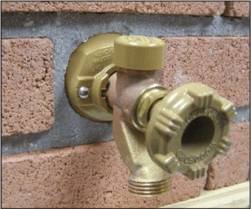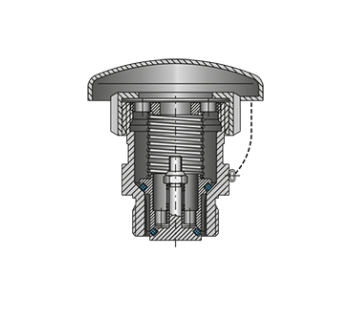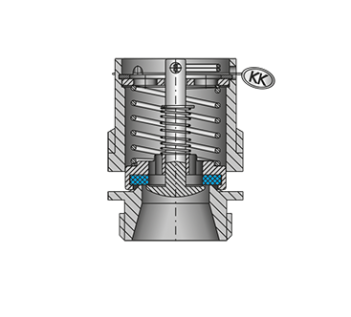
The following document is intended, for information purposes only, to all managers of private or public buildings who are looking to improve the protection of their drinking water system.
The importance of Atmospheric and Hose Connection Vacuum Breakers
Drinking water, this proecious and important resource, must be properly preserved and protected for the health of the public. This task becomes a shared responsibility, as many people would be affected by contamination of the drinking water network of a municipality or a building.
A simple way to provide quick protection for a potential contamination risk from a hose is to install devices called atmospheric vacuum breakers or hose connection vacuum breakers on the building's exterior and interior faucets.
A vacuum breaker is a backflow preventer device that prevents the back-siphonage of water from a hose into the water system. If, unfortunately, the upstream pressure, i.e. before the location of the vacuum breaker, is reduced, the water after the device escapes through a pipe on top pf the vacuum breaker. This conduit, called a vent, prevents water from returning to the water system. Without protection, this water, possibly contaminated, is now circulating in the building's drinking water pipes. If this water is ingested by an occupant of the facility, serious health consequences could ensue.
A simple example of a situation that clearly demonstrates the importance of a vacuum breaker is the following:
Imagine a tap, in a building, connected to the drinking water network. A hose is then connected to it to fill a bucket of water, containing a detergent product, with the aim of washing a car. A contaminated water solution is then created. If, at the same moment, a pressure drop occurs in the water supply system, either from a nearby pipe break or from heavy use elsewhere in the network, then water from the bucket could be drawn into the drinking water system.
Without a vacuum breaker installed, this contaminated solution could then end up in the building's water pipes or those of the municipality, thus endangering the health of the building's users or that of the public.
Atmospheric Vacuum Breakers: a barrier against backflow
Atmospheric Vacuum Breakers (AVB) use atmospheric pressure to slow the reflux of contaminated water into the drinking water system. However, these are not effective against back pressure.

To ensure the longevity of this device, it is important to comply with certain technical specifications specific to it. First, it must not be connected in such a way as to receive water in continuous circulation for more than 12 hours. Such use would cause the check valve to jam in the open position, thus rendering the device inoperative in the event of siphoning. Also, the critical level, i.e. the lowest point of the device without any indication to the contrary, must be at least 25 mm above the potential overflow level of the accessory to which it is connected.
Hose Connection Vaccum Breakers: adaptability
Hose Connection Vacuum Breakers (HCVB) are intended to be installed on the outlet of garden hose faucets. Similar to AVBs these devices resist back siphonage into the drinking water system. An interesting aspect of their use is that they have the advantage of being able to be easily and quickly attached to an existing and functional faucet.

It should also be noted that HCVB are initially approved to address contamination risks that are considered low. Faucets, whether located outdoors or indoors, are assessed as having moderate risk of contamination, so it is more appropriate to install a AVB approved for such risks.
Practices for the maintenance and use of vacuum breakers
To allow for optimal operation of the device throughout its lifetime, certain actions are recommended.
First of all, it is important to carry out regular checks on the condition of the vacuum breakers. It is simple, each time they are used, to ensure visually that no breakage, corrosion or excessive accumulation of dirt is present.
When the vacuum breaker is subjected to particular environmental conditions, such as severe periods of cold weather, more regular maintenance should be considered. This involves completely draining the faucet and the vacuum breaker, to prevent any accumulation of water inside the device, or installing an insulating box around the vacuum breaker, to keep temperatures more stable.
In summary, the installation of an atmospheric or hose connection vacuum breaker on the exterior or interior faucets of a building is a preventive initiative in the protection of any drinking water network. These simple devices help maintaining the safe drinking quality of the water, as well as ensuring the health and safety of the community.
References:
Canadian Food Inspection Agency. (2021). Preventing water backflow. Site web de l'Agence canadienne d'inspection des aliments
CSA Group. (2023). CSA B64.10:23/CSA B64.10.1:23 (R2021) Selection and installation of backflow preventers/Maintenance and field testing of backflow preventers. Site web de CSA Group
Régie du bâtiment du Québec. (2023). Installer et vérifier un dispositif anti-refoulement, c'est obligatoire. Site web de la Régie du bâtiment du Québec
Gouvernement du Québec. (2023). Quoi faire avant, pendant et après une urgence ou un sinistre: Contamination ou pénurie d'eau potable. https://www.quebec.ca/securite-situations-urgence/urgences-sinistres-risques-naturels/quoi-faire-avant-pendant-apres-urgence-sinistre/contamination-ou-penurie-eau-potable
Woodford Manufacturing Company. (n.d.). Modèle 19 - Robinet mural Woodford. Woodford Manufacturing. https://www.woodfordmfg.com/woodford/Wall_Faucet_Pages/Model-19.html
Kieselmann. (n.d.). Vannes casse vide. Site Web. France: Kieselmann. https://www.kieselmann.fr/produits/vannes-de-cuves/vannes-casse-vide/